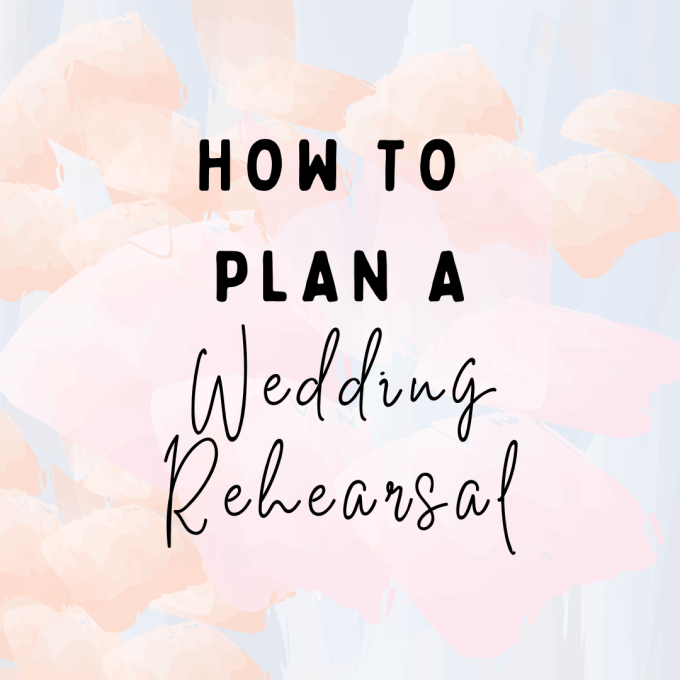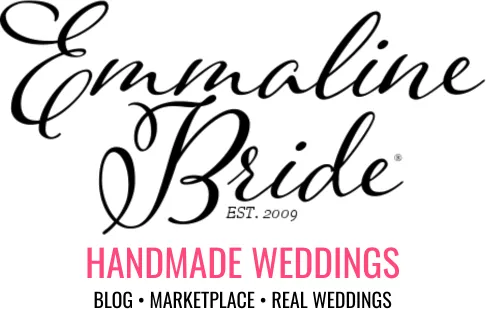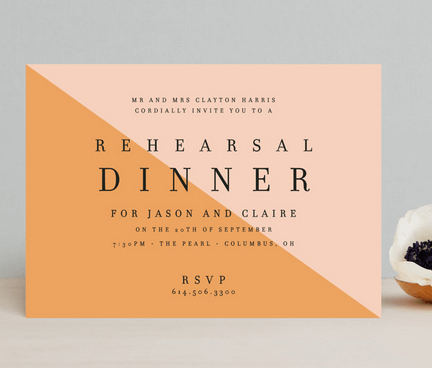After you’ve spent months planning, your wedding day is right around the corner. It’s such an exciting time!
Now you’ll want to plan out your rehearsal so it goes off without a hitch. In this blog post, I’ll tell you everything you need to know about how to plan a wedding rehearsal from start to finish. I’ll also tell you who, what, when, where, and why so you don’t have any unexpected questions along the way.
And last but not least, you’ll learn tips on how to direct a wedding rehearsal without a wedding coordinator (although I highly encourage having one — it’s vital to an organized and streamlined event). P.S. In Michigan? You can hire us!
Let’s get started!

Let’s get started!
• VIDEO: Watch the quick video reel here.
How To Plan a Wedding Rehearsal
First, let’s talk about what you need to know: who attends, what it is, when, where it takes place, and how to do a wedding rehearsal from start to finish.
Who Attends a Wedding Rehearsal?
Who should you invite?
The people who should attend a rehearsal are only those who play a role in the ceremony.
This includes:
• The Couple
• Parents of the Couple
• Wedding Party: Bridesmaids and Groomsmen
• Ushers
• Readers
• Flower Girl
• Ring Bearer
• Musician(s)
• Officiant
… and anyone else who has a role in the wedding, if any.
What is a Rehearsal?
A rehearsal for a wedding is practice, or a run-through, of the ceremony before the big day arrives.
It usually lasts about an hour, but I highly recommend scheduling at least an hour and fifteen minutes to allow for people to arrive on time and for any questions or additional practice, if needed.
When is the Ceremony Rehearsal?
Your venue determines the date of the rehearsal based on availability, but it typically takes place the night before or two nights before your wedding day.
What Do You Wear to Rehearse?
The dress code of a ceremony rehearsal is determined by the couple. Traditionally, attendees wear semi-formal (slightly dressy) attire, as you’ll be gathering for dinner following the rehearsal. If you’re unsure, use the dinner’s venue as a guide. If it is formal, ask guests to dress formally. For more casual faire, guests can dress in casual attire.
Send rehearsal dinner invitations at least 4 weeks before the event and include dress code, if you wish, on the invite (or via your wedding website).
Where Does It Take Place?
You will rehearse at your ceremony venue. This way, guests know exactly where to be and can walk through nearly identically to the big day itself.
Now that you know the basics, let’s talk about HOW to do a rehearsal, step-by-step.
Your wedding officiant will run-through the rehearsal for you, making sure to keep an eye on everything and ensure it goes smoothly. This is crucial to have, as they will maintain organization for you on the rehearsal day and wedding day. I strongly advise you to have a day-of coordinator who assists with the rehearsal.
If not, no worries. This rehearsal guide to help you plan yours including all the most important parts so you don’t forget a thing.
How To Plan a Wedding Rehearsal
First, you’ll want to give a quick intro.
Intro
Greet guests and thank them for coming to the rehearsal. Let them know you’re going to run through the ceremony so everyone is confident for the big day and there will be plenty of time for questions.
Ushers
Show the ushers to where they’ll be escorting guests. If they are passing out ceremony programs, instruct them to where the programs will be held and how many to give to guests (one per guest or per household, based on how many programs you ordered).
Processional Order
The most important part of the ceremony rehearsal is the processional order. Getting it right is an art-form in itself, with perfect timing and music at just the right points.
Read: How to Lineup for a Wedding Ceremony: The Procession Order
With your musician, go over the music planned for the ceremony procession and listen to a sample of it at this time. This will make it easy for those with roles in the wedding to know exactly when to begin processing down the aisle.
The key to a perfect procession is timing. Make sure no one is going too fast or too slow. Practice the procession until the timing is right.
A traditional processional order is as follows, however, you should create your own perfect processional order ahead of time and line up your attendees accordingly.
Here’s a sample:
► Officiant
► Groom
► Best Man
► Groomsmen / Bridesmaids
► Maid of Honor
► Ring Bearer
► Flower Girl
► Bride and Her Father
As I said, feel free to plan it however you wish. Decide how you want your mom and your partners’ parents to be escorted down the aisle ahead of the procession (typically with ushers).
Figure out where you want them to sit, as well.
Once the procession has been practiced, have everyone take their seats or places at the altar (bridesmaids typically stand on the left of the bride, while groomsmen stand on the right of the groom).
Readings and Music / Roles
Next, you’ll have anyone with a reading practice it as this time. They should speak loudly and clearly in the microphone and get used to speaking at the podium.
This is a great time to make sure they have the exact reading they need for the wedding (and if not, get a copy to them now). They can read through it once or twice, until they’re comfortable.
You should also instruct them where to go to stand, and at what queue to listen to for their turn. (It’s usually, “Now we’ll have a reading from the bride’s Aunt Lucy…” or something similar.)
Anyone else with a role — a reading, a poem, lighting of a candle, etc. — should be practiced at this time, as well.
Officiant Rehearsal of the Ceremony
The officiant won’t read through the entire ceremony, but will give a brief summary at this time of how the order of events will occur. It’s a great idea to go over the reciting of vows and exchanging of rings, although you won’t read your actual vows or exchange rings just yet. You’ll only practice the events, so you know when they occur, where to stand, how to get comfortable in front of the microphone, etc.
At this time, you’ll practice the retrieval of the rings from the Best Man, or whomever you have in charge of them, so it’s seamless on the wedding day.
Recessional
Once you’ve done the above, practice the recessional of the ceremony. This is when you’ll be exciting the ceremony with your partner, newly married (yay!) The recessional occurs similarly to the procession, only in reverse order, with the newlyweds leading the group.
Next you’ll decide where you’ll go once you exit. Typically, you’ll immediately go to sign the marriage license to make it official. Decide where that will take place (your photographer will want to snap pictures of this!) And make sure the witnesses know where to be for signing it.
Finally, you’ll decide if you want to do a receiving line immediately after the signing of the marriage certificate, or if you want to exit to take photos straightaway.
Practice Processional and Recessional Once More
Practice makes perfect: go through the processional and recessional one more time to make sure everyone feels comfortable with where to be, at what time, and it goes smoothly.
Once you’re happy with it… there’s one more step. Questions!
Questions
Last but not least, leave some time at the rehearsal for any questions to be answered. Now is a great time to ask anyone if there are any questions about where to be, when, how to do their role, etc.
That just about does it!
Immediately following the rehearsal, guests will attend the rehearsal dinner together. This is where you’ll enjoy a nice meal together and celebrate the big day’s arrival just a day or two away.
The rehearsal dinner is also the optimum time to give your wedding party and parents’ gifts. Present your bridesmaids, groomsmen, and parents with gifts to show your appreciation for their support leading up to and including your wedding day.
GIFT SUGGESTIONS:
• 50 Most Unique Bridesmaid Gift Ideas for 2023
• 84 Best Groomsmen Gifts That Are Useful for 2023
• 30+ Best Wedding Gifts for Parents
TIMELINE:
Lastly, make sure your wedding day timeline is properly updated.
• Create Your Wedding Day Timeline Now
If you have any additional questions, let me know in the comments below!
Happy Planning!
xo
Emma



